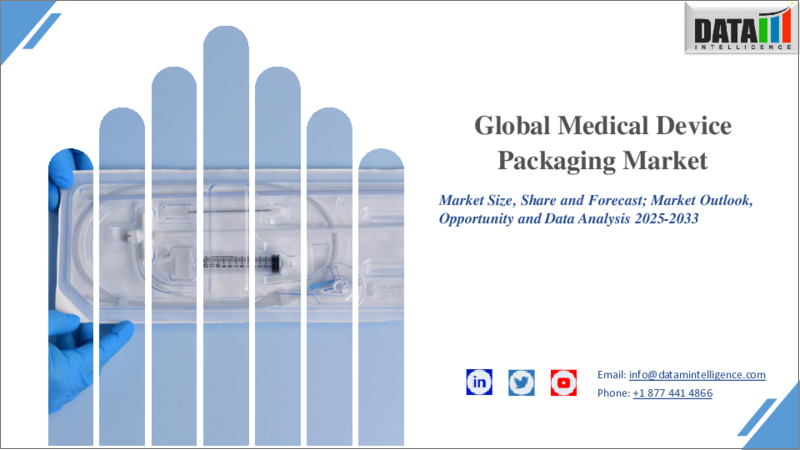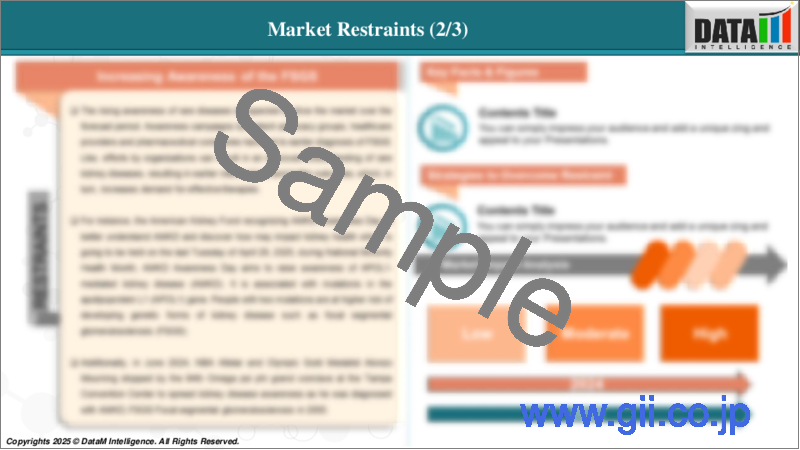|
|
市場調査レポート
商品コード
1643932
医療機器包装の世界市場(2025年~2033年)Global Medical Device Packaging Market - 2025-2033 |
||||||
カスタマイズ可能
適宜更新あり
|
|||||||
| 医療機器包装の世界市場(2025年~2033年) |
|
出版日: 2025年01月27日
発行: DataM Intelligence
ページ情報: 英文 166 Pages
納期: 即日から翌営業日
|
- 全表示
- 概要
- 目次
世界の医療機器包装の市場規模は、2024年に395億米ドルに達し、2033年には688億米ドルに達すると予測され、予測期間2025年~2033年のCAGRは6.4%で成長する見通しです。
医療機器包装とは、医療機器の保管、取り扱い、輸送中の汚染、損傷、劣化から保護するために使用される資材、システム、プロセスを指します。包装は、医療機器の安全性、無菌性(必要な場合)、完全性、機能性を確保し、FDA、ISO、EU規制などの規制要件に適合するように設計されています。無菌環境を必要とする器具の場合、包装は器具が使用されるまで汚染物質がないことを保証します。これは、手術器具、埋め込み型器具、診断ツールにとって特に重要です。
世界の医療機器包装市場は、医療機器の技術的進歩、患者の安全と感染予防の重視の高まり、医療機器に対する需要の高まりなどの要因によって、大きな成長を遂げています。例えば、米国食品医薬品局によると、確立された市販前経路によって1,000以上のAI対応機器を認可しています。このような医療機器認可の増加は、医療機器包装の需要を押し上げています。
市場力学:
促進要因と抑制要因
持続可能な医療機器包装に対する需要の高まり
持続可能な医療機器包装に対する需要の高まりは、医療機器包装市場の成長を大きく後押ししており、予測期間中も市場を牽引していくと予想されます。環境への懸念が強まるにつれ、医療提供者やメーカーは二酸化炭素排出量を削減し、規制要件を満たすために、環境に優しい包装ソリューションを採用する傾向が強まっています。そのため、多くの市場関係者が持続可能な包装製品の開発に注力しています。
例えば、Klockner Pentaplast(kp)は2024年10月、kpNextブランドを医薬品用ブリスターフィルムの枠を超え、医療機器市場に進出させる新しい医療機器包装フィルム、kpNext MDR1を発表しました。この革新的なソリューションは、医療包装における持続可能な包装オプションに対する需要の高まりに応えることを目的としています。この新しいkpNext MDR1フィルムにより、医療提供者は包装資材の品質や性能に妥協することなく、持続可能性を優先することができます。
さらに、医療包装の廃棄物増加を受けて、世界各国の政府はプラスチック廃棄物を削減し、リサイクルを促進するための厳しい規制を実施しています。例えば、米国医師会によると、米国の医療施設で毎日発生する1万4,000トンの廃棄物のうち、約20%~25%がプラスチックです。しかし、医療で使用されるものを含め、プラスチックの91%はリサイクルされずに埋め立て地に捨てられたり、自然の生息地に入り込んだりしています。
厳しい規制要件
厳しい規制要件は、メーカーが遵守しなければならない厳格な基準を課すことにより、医療機器包装市場に大きな影響を与え、市場力学に影響を与えています。医療機器包装の承認プロセスには時間がかかり、膨大な文書化、試験、認証が必要となります。このため、新しい包装ソリューションの導入が遅れ、技術革新や市場の要求への対応が妨げられる可能性があります。製造業者は、必要な承認を得るために、技術仕様書、リスク管理文書、臨床試験結果を含む詳細な書類を作成し、提出しなければなりません。
例えば、欧州連合(EU)では、医療機器は市販される前に、厳しい要件を満たすことを確認するための販売承認プロセスを経なければなりません。このプロセスには、機器の一般的説明、技術仕様、臨床試験結果などの特定の情報を含む書類一式の作成と提出が含まれます。
目次
第1章 市場イントロダクションと範囲
- レポートの目的
- 調査のカバー範囲と定義
- 調査の対象範囲
第2章 エグゼクティブの洞察と重要なポイント
- 市場のハイライトと戦略的ポイント
- 主な動向と将来の予測
- 製品タイプ別のスニペット
- 材料別のスニペット
- 包装タイプ別のスニペット
- 用途別のスニペット
- エンドユーザー別のスニペット
- 地域別のスニペット
第3章 市場力学
- 影響要因
- 促進要因
- 持続可能な医療機器包装への需要の高まり
- 抑制要因
- 厳格な規制要件
- 機会
- 影響分析
- 促進要因
第4章 戦略的洞察と業界展望
- 市場のリーダーと先駆者
- 新たな先駆者と著名な企業
- 最大の売上を誇るブランドを確立したリーダー
- 確立された製品を持つ市場リーダー
- 新興スタートアップ企業と主要イノベーター
- CXOの視点
- 最新の開発とブレークスルー
- ケーススタディ/進行中の研究
- 規制と償還の情勢
- 北米
- 欧州
- アジア太平洋
- ラテンアメリカ
- 中東・アフリカ
- ポーターのファイブフォース分析
- サプライチェーン分析
- 特許分析
- SWOT分析
- アンメットニーズとギャップ
- 市場参入と拡大のための推奨戦略
- シナリオ分析ベストケース、ベースケース、ワーストケースの予測
第5章 医療機器包装市場:製品タイプ別
- トレイ
- 箱
- パウチと袋
- クラムシェルパック
- ブリスターパック
- フィルム
- その他
第6章 医療機器包装市場:材料別
- プラスチック
- 金属
- 紙および板紙
- ガラス
- その他
第7章 医療機器包装市場:包装タイプ別
- 一次包装
- 二次包装
- 三次包装
第8章 医療機器包装市場:用途別
- 滅菌包装
- 非滅菌包装
第9章 医療機器包装市場:エンドユーザー別
- 医療機器メーカー
- 契約製造企業
第10章 医療機器包装市場:地域別の市場分析と成長機会
- 北米
- 米国
- カナダ
- メキシコ
- 欧州
- ドイツ
- 英国
- フランス
- スペイン
- イタリア
- その他欧州
- 南米
- ブラジル
- アルゼンチン
- その他南米
- アジア太平洋
- 中国
- インド
- 日本
- 韓国
- その他アジア太平洋
- 中東・アフリカ
第11章 競合情勢と市場ポジショニング
- 競合状況の概要と主要な市場企業
- 市場シェア分析とポジショニングマトリックス
- 戦略的パートナーシップ、合併、買収
- 製品ポートフォリオとイノベーションにおける主な発展
- 企業ベンチマーク
第12章 企業プロファイル
- Amcor plc
- 会社概要
- 製品ポートフォリオと概要
- 財務概要
- 主な発展
- SWOT分析
- DuPont
- Berry Global Inc.
- WestRock Company
- 3M
- Sonoco Products Company
- Wihuri Group
- AptarGroup, Inc.
- Oliver Healthcare Packaging
- Printpack
第13章 前提条件と調査手法
- データ収集方法
- データの三角測量
- 予測技術
- データの検証とバリデーション
第14章 付録
The global medical device packaging market reached US$ 39.5 billion in 2024 and is expected to reach US$ 68.8 billion by 2033, growing at a CAGR of 6.4% during the forecast period 2025-2033.
Medical device packaging refers to the materials, systems, and processes used to enclose and protect medical devices from contamination, damage and deterioration during storage, handling, and transportation. The packaging is designed to ensure the device's safety, sterility (if necessary), integrity and functionality maintaining compliance with regulatory requirements set by organizations such as the FDA, ISO and EU regulations. For devices that require a sterile environment, packaging ensures that the device remains free from contaminants until it is used. This is particularly important for surgical instruments, implantable devices, and diagnostic tools.
The global medical device packaging market is experiencing significant growth, driven by factors such as technological advancements in medical devices, a rising emphasis on patient safety and infection prevention and rising demand for medical devices. For instance, according to the U.S. Food & Drug Administration, it has authorized more than 1,000 AI-enabled devices by the established premarket pathways. These rising medical device approvals boosting the demand for medical device packaging.
Market Dynamics: Drivers & Restraints
Rising demand for sustainable medical device packaging
The rising demand for sustainable medical device packaging is significantly driving the growth of the Medical Device Packaging market and is expected to drive the market over the forecast period. As environmental concerns intensify, healthcare providers and manufacturers are increasingly adopting eco-friendly packaging solutions to reduce their carbon footprint and meet regulatory requirements. Thus, many market players are focussing on the development of sustainable packaging products.
For instance, in October 2024, Klockner Pentaplast (kp) introduced kpNext MDR1, a new medical device packaging film that takes the kpNext brand beyond pharmaceutical blister films and into the medical device market. This innovative solution is intended to fulfill the growing demand for sustainable packaging options in healthcare packaging. This new kpNext MDR1 film allows healthcare providers to prioritize sustainability, without compromising on the quality or performance of their packaging materials.
Additionally, governments worldwide are implementing stringent regulations to reduce plastic waste and promote recycling due to rising healthcare packaging waste. For instance, according to the American Medical Association, of the 14,000 tons of waste created daily in US healthcare facilities, around 20% to 25% is plastic. However, 91% of plastics, including those used in health care, are not recycled and end up in landfills or have penetrated natural habitats.
Stringent regulatory requirements
Stringent regulatory requirements significantly impact the medical device packaging market by imposing rigorous standards that manufacturers must adhere to, thereby influencing market dynamics. The approval process for medical device packaging is time-consuming, involving extensive documentation, testing, and certification. This delays the introduction of new packaging solutions, potentially hindering innovation and responsiveness to market demands. Manufacturers must prepare and submit detailed dossiers, including technical specifications, risk management documentation, and clinical test results, to obtain necessary approvals.
For instance, in the European Union, medical devices must undergo a marketing authorization process to ensure they meet stringent requirements before being marketed. This process includes preparing and submitting a dossier containing specific information, such as the device's general description, technical specifications, and clinical test results.
Segment Analysis
The global medical device packaging market is segmented based on product type, material, packaging type, application, end-user and region.
Product Type:
The films segment is expected to dominate the medical device packaging market share
Films offer a wide range of properties, including moisture, oxygen, and light barriers, essential for preserving the integrity of medical devices. They can be tailored to specific requirements, such as sterilization compatibility and mechanical strength. Thus, many market players are focussing on the development of films for medical device packaging.
For instance, in November 2023, Coveris, a flexible packaging provider, created a recyclable thermoforming film designed for medical device applications. Formpeel P joins Coveris' portfolio of sustainable materials, which also includes Formpeel T, Flexopeel T, and Cleerpeel. It offers the same performance and safety as traditional materials while reducing packaging and product waste, according to the business.
Films are generally more affordable compared to other packaging materials like rigid containers, making them a preferred choice for manufacturers aiming to balance quality and cost. Films can be engineered to meet stringent regulatory standards, ensuring safety and efficacy in medical device packaging leading to market dominance.
Geographical Analysis
North America is expected to hold a significant position in the medical device packaging market share
North America especially in the United States boasts a well-developed healthcare system, leading to a high demand for advanced medical devices and, consequently, sophisticated packaging solutions. North America is home to numerous prominent and emerging medical device manufacturers and packaging companies, fostering innovation and competition within the market. Key players in the region include Amcor plc, DuPont, and Berry Global, among others.
The region is at the forefront of adopting new technologies in medical device packaging, such as smart packaging solutions and sustainable materials, enhancing the quality, sterility, functionality and appeal of packaging products. For instance, in April 2024, STEMart launched its packaging solutions for the pharmaceutical and medical device industries to meet the unique needs of the medical device industries. These services are designed to ensure the quality, sterility, and regulatory compliance of medical devices throughout their lifecycle.
Asia-Pacific is growing at the fastest pace in the medical device packaging market
Rising healthcare investments in countries like China, India, and Japan are fueling the growth of the medical device market, which in turn drives demand for packaging solutions. As disposable incomes rise, people are increasingly seeking better healthcare services, which translates to higher consumption of medical devices and their packaging. For instance, the healthcare sector in China and India is rapidly expanding, and both are predicted to lead in the adoption of advanced medical device packaging solutions.
Regulatory agencies in countries like China and India have become stricter in terms of product safety and packaging standards. The imposition of these standards is pushing medical device manufacturers to adopt high-quality and reliable packaging solutions to comply with regulations. The adoption of global standards like ISO and GMP (Good Manufacturing Practices) is also contributing to the growth of the market.
Competitive Landscape
The major global players in the medical device packaging market include Amcor plc, DuPont, Berry Global Inc., WestRock Company, 3M, Sonoco Products Company, Wihuri Group, AptarGroup, Inc., Oliver Healthcare Packaging, Printpack and among others.
Why Purchase the Report?
- Pipeline & Innovations: Reviews ongoing clinical trials, product pipelines, and forecasts upcoming advancements in medical devices and pharmaceuticals.
- Product Performance & Market Positioning: Analyzes product performance, market positioning, and growth potential to optimize strategies.
- Real-World Evidence: Integrates patient feedback and data into product development for improved outcomes.
- Physician Preferences & Health System Impact: Examines healthcare provider behaviors and the impact of health system mergers on adoption strategies.
- Market Updates & Industry Changes: Covers recent regulatory changes, new policies, and emerging technologies.
- Competitive Strategies: Analyzes competitor strategies, market share, and emerging players.
- Pricing & Market Access: Reviews pricing models, reimbursement trends, and market access strategies.
- Market Entry & Expansion: Identifies optimal strategies for entering new markets and partnerships.
- Regional Growth & Investment: Highlights high-growth regions and investment opportunities.
- Supply Chain Optimization: Assesses supply chain risks and distribution strategies for efficient product delivery.
- Sustainability & Regulatory Impact: Focuses on eco-friendly practices and evolving regulations in healthcare.
- Post-market Surveillance: Uses post-market data to enhance product safety and access.
- Pharmacoeconomics & Value-Based Pricing: Analyzes the shift to value-based pricing and data-driven decision-making in R&D.
The global Medical Device Packaging market report delivers a detailed analysis with 78 key tables, more than 76 visually impactful figures, and 166 pages of expert insights, providing a complete view of the market landscape.
Target Audience 2024
- Manufacturers: Pharmaceutical, Medical Device, Biotech Companies, Contract Manufacturers, Distributors, Hospitals.
- Regulatory & Policy: Compliance Officers, Government, Health Economists, Market Access Specialists.
- Technology & Innovation: AI/Robotics Providers, R&D Professionals, Clinical Trial Managers, Pharmacovigilance Experts.
- Investors: Healthcare Investors, Venture Fund Investors, Pharma Marketing & Sales.
- Consulting & Advisory: Healthcare Consultants, Industry Associations, Analysts.
- Supply Chain: Distribution and Supply Chain Managers.
- Consumers & Advocacy: Patients, Advocacy Groups, Insurance Companies.
- Academic & Research: Academic Institutions.
Table of Contents
1. Market Introduction and Scope
- 1.1. Objectives of the Report
- 1.2. Report Coverage & Definitions
- 1.3. Report Scope
2. Executive Insights and Key Takeaways
- 2.1. Market Highlights and Strategic Takeaways
- 2.2. Key Trends and Future Projections
- 2.3. Snippet by Product Type
- 2.4. Snippet by Material
- 2.5. Snippet by Packaging Type
- 2.6. Snippet by Application
- 2.7. Snippet by End-User
- 2.8. Snippet by Region
3. Dynamics
- 3.1. Impacting Factors
- 3.1.1. Drivers
- 3.1.1.1. Rising Demand for Sustainable Medical Device Packaging
- 3.1.2. Restraints
- 3.1.2.1. Stringent Regulatory Requirements
- 3.1.3. Opportunity
- 3.1.4. Impact Analysis
- 3.1.1. Drivers
4. Strategic Insights and Industry Outlook
- 4.1. Market Leaders and Pioneers
- 4.1.1. Emerging Pioneers and Prominent Players
- 4.1.2. Established leaders with largest selling Brand
- 4.1.3. Market leaders with established Product
- 4.2. Emerging Startups and Key Innovators
- 4.3. CXO Perspectives
- 4.4. Latest Developments and Breakthroughs
- 4.5. Case Studies/Ongoing Research
- 4.6. Regulatory and Reimbursement Landscape
- 4.6.1. North America
- 4.6.2. Europe
- 4.6.3. Asia Pacific
- 4.6.4. Latin America
- 4.6.5. Middle East & Africa
- 4.7. Porter's Five Force Analysis
- 4.8. Supply Chain Analysis
- 4.9. Patent Analysis
- 4.10. SWOT Analysis
- 4.11. Unmet Needs and Gaps
- 4.12. Recommended Strategies for Market Entry and Expansion
- 4.13. Scenario Analysis: Best-Case, Base-Case, and Worst-Case Forecasts
5. Medical Device Packaging Market, By Product Type
- 5.1. Introduction
- 5.1.1. Market Size Analysis and Y-o-Y Growth Analysis (%), By Product Type
- 5.1.2. Market Attractiveness Index, By Product Type
- 5.2. Trays*
- 5.2.1. Introduction
- 5.2.2. Market Size Analysis and Y-o-Y Growth Analysis (%)
- 5.3. Boxes
- 5.4. Pouches and Bags
- 5.5. Clamshell Packs
- 5.6. Blisters
- 5.7. Films
- 5.8. Others
6. Medical Device Packaging Market, By Material
- 6.1. Introduction
- 6.1.1. Market Size Analysis and Y-o-Y Growth Analysis (%), By Material
- 6.1.2. Market Attractiveness Index, By Material
- 6.2. Plastic*
- 6.2.1. Introduction
- 6.2.2. Market Size Analysis and Y-o-Y Growth Analysis (%)
- 6.3. Metal
- 6.4. Paper and Paperboard
- 6.5. Glass
- 6.6. Others
7. Medical Device Packaging Market, By Packaging Type
- 7.1. Introduction
- 7.1.1. Market Size Analysis and Y-o-Y Growth Analysis (%), By Packaging Type
- 7.1.2. Market Attractiveness Index, By Packaging Type
- 7.2. Primary Packaging*
- 7.2.1. Introduction
- 7.2.2. Market Size Analysis and Y-o-Y Growth Analysis (%)
- 7.3. Secondary Packaging
- 7.4. Tertiary Packaging
8. Medical Device Packaging Market, By Application
- 8.1. Introduction
- 8.1.1. Market Size Analysis and Y-o-Y Growth Analysis (%), By Application
- 8.1.2. Market Attractiveness Index, By Application
- 8.2. Sterile Packaging*
- 8.2.1. Introduction
- 8.2.2. Market Size Analysis and Y-o-Y Growth Analysis (%)
- 8.3. Non-Sterile Packaging
9. Medical Device Packaging Market, By End-User
- 9.1. Introduction
- 9.1.1. Market Size Analysis and Y-o-Y Growth Analysis (%), By End-User
- 9.1.2. Market Attractiveness Index, By End-User
- 9.2. Medical Device Manufacturers*
- 9.2.1. Introduction
- 9.2.2. Market Size Analysis and Y-o-Y Growth Analysis (%)
- 9.3. Contract Manufacturing Organizations
10. Medical Device Packaging Market, By Regional Market Analysis and Growth Opportunities
- 10.1. Introduction
- 10.1.1. Market Size Analysis and Y-o-Y Growth Analysis (%), By Region
- 10.1.2. Market Attractiveness Index, By Region
- 10.2. North America
- 10.2.1. Introduction
- 10.2.2. Key Region-Specific Dynamics
- 10.2.3. Market Size Analysis and Y-o-Y Growth Analysis (%), By Product Type
- 10.2.4. Market Size Analysis and Y-o-Y Growth Analysis (%), By Material
- 10.2.5. Market Size Analysis and Y-o-Y Growth Analysis (%), By Packaging Type
- 10.2.6. Market Size Analysis and Y-o-Y Growth Analysis (%), By Application
- 10.2.7. Market Size Analysis and Y-o-Y Growth Analysis (%), By End-User
- 10.2.8. Market Size Analysis and Y-o-Y Growth Analysis (%), By Country
- 10.2.8.1. U.S.
- 10.2.8.2. Canada
- 10.2.8.3. Mexico
- 10.3. Europe
- 10.3.1. Introduction
- 10.3.2. Key Region-Specific Dynamics
- 10.3.3. Market Size Analysis and Y-o-Y Growth Analysis (%), By Product Type
- 10.3.4. Market Size Analysis and Y-o-Y Growth Analysis (%), By Material
- 10.3.5. Market Size Analysis and Y-o-Y Growth Analysis (%), By Packaging Type
- 10.3.6. Market Size Analysis and Y-o-Y Growth Analysis (%), By Application
- 10.3.7. Market Size Analysis and Y-o-Y Growth Analysis (%), By End-User
- 10.3.8. Market Size Analysis and Y-o-Y Growth Analysis (%), By Country
- 10.3.8.1. Germany
- 10.3.8.2. U.K.
- 10.3.8.3. France
- 10.3.8.4. Spain
- 10.3.8.5. Italy
- 10.3.8.6. Rest of Europe
- 10.4. South America
- 10.4.1. Introduction
- 10.4.2. Key Region-Specific Dynamics
- 10.4.3. Market Size Analysis and Y-o-Y Growth Analysis (%), By Product Type
- 10.4.4. Market Size Analysis and Y-o-Y Growth Analysis (%), By Material
- 10.4.5. Market Size Analysis and Y-o-Y Growth Analysis (%), By Packaging Type
- 10.4.6. Market Size Analysis and Y-o-Y Growth Analysis (%), By Application
- 10.4.7. Market Size Analysis and Y-o-Y Growth Analysis (%), By End-User
- 10.4.8. Market Size Analysis and Y-o-Y Growth Analysis (%), By Country
- 10.4.8.1. Brazil
- 10.4.8.2. Argentina
- 10.4.8.3. Rest of South America
- 10.5. Asia-Pacific
- 10.5.1. Introduction
- 10.5.2. Key Region-Specific Dynamics
- 10.5.3. Market Size Analysis and Y-o-Y Growth Analysis (%), By Product Type
- 10.5.4. Market Size Analysis and Y-o-Y Growth Analysis (%), By Material
- 10.5.5. Market Size Analysis and Y-o-Y Growth Analysis (%), By Packaging Type
- 10.5.6. Market Size Analysis and Y-o-Y Growth Analysis (%), By Application
- 10.5.7. Market Size Analysis and Y-o-Y Growth Analysis (%), By End-User
- 10.5.8. Market Size Analysis and Y-o-Y Growth Analysis (%), By Country
- 10.5.8.1. China
- 10.5.8.2. India
- 10.5.8.3. Japan
- 10.5.8.4. South Korea
- 10.5.8.5. Rest of Asia-Pacific
- 10.6. Middle East and Africa
- 10.6.1. Introduction
- 10.6.2. Key Region-Specific Dynamics
- 10.6.3. Market Size Analysis and Y-o-Y Growth Analysis (%), By Product Type
- 10.6.4. Market Size Analysis and Y-o-Y Growth Analysis (%), By Material
- 10.6.5. Market Size Analysis and Y-o-Y Growth Analysis (%), By Packaging Type
- 10.6.6. Market Size Analysis and Y-o-Y Growth Analysis (%), By Application
- 10.6.7. Market Size Analysis and Y-o-Y Growth Analysis (%), By End-User
11. Competitive Landscape and Market Positioning
- 11.1. Competitive Overview and Key Market Players
- 11.2. Market Share Analysis and Positioning Matrix
- 11.3. Strategic Partnerships, Mergers & Acquisitions
- 11.4. Key Developments in Product Portfolios and Innovations
- 11.5. Company Benchmarking
12. Company Profiles
- 12.1. Amcor plc*
- 12.1.1. Company Overview
- 12.1.2. Product Portfolio and Description
- 12.1.3. Financial Overview
- 12.1.4. Key Developments
- 12.1.5. SWOT Analysis
- 12.2. DuPont
- 12.3. Berry Global Inc.
- 12.4. WestRock Company
- 12.5. 3M
- 12.6. Sonoco Products Company
- 12.7. Wihuri Group
- 12.8. AptarGroup, Inc.
- 12.9. Oliver Healthcare Packaging
- 12.10. Printpack
LIST NOT EXHAUSTIVE
13. Assumption and Research Methodology
- 13.1. Data Collection Methods
- 13.2. Data Triangulation
- 13.3. Forecasting Techniques
- 13.4. Data Verification and Validation
14. Appendix
- 14.1. About Us and Services
- 14.2. Contact Us






